top of page
Recent Artworks
Works completed during my senior year of high school where I stepped outside my comfort zone by using non-traditional mediums and multidisciplinary approaches. Concepts explored relate to the fields of psychology, sociology, and philosophy-- click on images for full descriptions.

The Grand Scheme
Acrylic on Canvas, 16 x 20 in.
This piece establishes a visual connection between two things that hold special meaning to me—sunsets and the game of Go.
To me, Go is not just a strategy board game. It is a world—one that begins with a blank slate, one where stones identical in function and value are placed in succession, and, unless captured, remains still. The 19 vertical and horizontal lines on the board form a grid of 361 points altogether, including nine dotted points, or “stars”. White and black stones represent day and night, while the center, called Tianyuán in Chinese, literally translates to the “center of heaven”.
In this painting, I use the rays of the setting sun as the lines of the Go board, merging it with the grandeur of the Grand Canyon. The hand reaching from the sky suggests a higher power controlling the scheme, conveying the sublime depth of the world of Go. The title, “The Grand Scheme”, is hence a play on words connecting these elements.
This piece establishes a visual connection between two things that hold special meaning to me—sunsets and the game of Go.
To me, Go is not just a strategy board game. It is a world—one that begins with a blank slate, one where stones identical in function and value are placed in succession, and, unless captured, remains still. The 19 vertical and horizontal lines on the board form a grid of 361 points altogether, including nine dotted points, or “stars”. White and black stones represent day and night, while the center, called Tianyuán in Chinese, literally translates to the “center of heaven”.
In this painting, I use the rays of the setting sun as the lines of the Go board, merging it with the grandeur of the Grand Canyon. The hand reaching from the sky suggests a higher power controlling the scheme, conveying the sublime depth of the world of Go. The title, “The Grand Scheme”, is hence a play on words connecting these elements.

The Vacuum
Acrylic on Canvas, 30 x 24 in.
Though inanimate, every object carries a narrative—an idea I sought to convey through this still life painting. Designed to organize chaos, the vacuum symbolizes humanity’s perpetual pursuit of order and control, juxtaposed by the disorderliness surrounding it. After fulfilling its role, it often ends up abandoned in a corner, ironically among the very messes it was meant to eradicate. To infuse life into this discarded vacuum, I introduced vibrant yellow and green lighting, creating a striking contrast with the cold, dull color palette.
Though inanimate, every object carries a narrative—an idea I sought to convey through this still life painting. Designed to organize chaos, the vacuum symbolizes humanity’s perpetual pursuit of order and control, juxtaposed by the disorderliness surrounding it. After fulfilling its role, it often ends up abandoned in a corner, ironically among the very messes it was meant to eradicate. To infuse life into this discarded vacuum, I introduced vibrant yellow and green lighting, creating a striking contrast with the cold, dull color palette.

Immortality
Acrylic and Leaves on Canvas, 20 x 16 in.
Falling leaves represent the final stage in the circle of life—decline… and death. The dry, wilted state of the leaves further symbolize the ephemerality and fragility of life. This is juxtaposed against a backdrop bursting with vibrant hues, while the elderly subject of the portrait wears a gentle smile. It is a visual ode to the intangible essence of humanity—a reminder that our imprints in the world enable us to transcend the constraints of time and space, allowing us to achieve a form of immortality.
Falling leaves represent the final stage in the circle of life—decline… and death. The dry, wilted state of the leaves further symbolize the ephemerality and fragility of life. This is juxtaposed against a backdrop bursting with vibrant hues, while the elderly subject of the portrait wears a gentle smile. It is a visual ode to the intangible essence of humanity—a reminder that our imprints in the world enable us to transcend the constraints of time and space, allowing us to achieve a form of immortality.

Abandoned
Acrylic on Canvas, 36 x 24 in.
This piece is a continuation of the exploration of the themes portrayed within “Immortality”.
Inspired by Matthew Christopher’s Abandoned America, which captures the lost history and essence of derelict buildings across the country, I depicted a rusting industrial syringe as a symbol for impermanence as well as the fleeting passage of time. The ominous, enclosing shadows consume everything within its bounds, signifying the ephemeral grandiosity of our industrial sector.
Yet, amidst this abandonment, there is hope. White highlights at the top indicate a source of light beyond the void of darkness, while the grass growing from beneath indicates new life. Instead of directly painting the blades of grass, I chose to scrape off paint from the pre-existing structure, conveying the strength and hardiness of life as it carves out a path for itself.
This piece is a continuation of the exploration of the themes portrayed within “Immortality”.
Inspired by Matthew Christopher’s Abandoned America, which captures the lost history and essence of derelict buildings across the country, I depicted a rusting industrial syringe as a symbol for impermanence as well as the fleeting passage of time. The ominous, enclosing shadows consume everything within its bounds, signifying the ephemeral grandiosity of our industrial sector.
Yet, amidst this abandonment, there is hope. White highlights at the top indicate a source of light beyond the void of darkness, while the grass growing from beneath indicates new life. Instead of directly painting the blades of grass, I chose to scrape off paint from the pre-existing structure, conveying the strength and hardiness of life as it carves out a path for itself.

Everyday Routine
Acrylic on Canvas, 20 x 16 in.
Often, people present idealized version of themselves, especially on social media. With this self portrait, I aimed to shatter that façade and reveal my raw, unguarded self, without concern for conventional beauty. The moment I have captured is an everyday, relatable one, designed to establish a personal connection with the viewer. The choice of a desaturated color palette, the presence of dripping water, and the exaggerated facial expression all work together to convey a heavy, disarrayed atmosphere that aligns with the setting of the piece.
Often, people present idealized version of themselves, especially on social media. With this self portrait, I aimed to shatter that façade and reveal my raw, unguarded self, without concern for conventional beauty. The moment I have captured is an everyday, relatable one, designed to establish a personal connection with the viewer. The choice of a desaturated color palette, the presence of dripping water, and the exaggerated facial expression all work together to convey a heavy, disarrayed atmosphere that aligns with the setting of the piece.

Cerberus
Acrylic and Collage on Canvas, 18 x 31 in.
Through this piece, I wanted to challenge the boundaries of both my personal comfort zone and the medium of acrylic. Rather than aiming for a precise physical representation of a dog, I sought to capture its essence in movement and form. Drawing inspiration from the Cubism movement, I portrayed multiple perspectives simultaneously, manifesting in three heads and exaggerated proportions.
Experimenting with various dilutions of acrylic paint—even manipulating dried acrylic paint for added effect—allowed me to achieve a diverse array of textures. The eyes, resembling a human-like quality, serve as a motif throughout the piece that evokes a sense of unease in the viewer. Each brush stroke, infused with multiple colors, is deliberate and bold. Geometric shapes cut out from newspaper and magazine pages resemble claws, extending beyond the border of the canvas.
Through this piece, I wanted to challenge the boundaries of both my personal comfort zone and the medium of acrylic. Rather than aiming for a precise physical representation of a dog, I sought to capture its essence in movement and form. Drawing inspiration from the Cubism movement, I portrayed multiple perspectives simultaneously, manifesting in three heads and exaggerated proportions.
Experimenting with various dilutions of acrylic paint—even manipulating dried acrylic paint for added effect—allowed me to achieve a diverse array of textures. The eyes, resembling a human-like quality, serve as a motif throughout the piece that evokes a sense of unease in the viewer. Each brush stroke, infused with multiple colors, is deliberate and bold. Geometric shapes cut out from newspaper and magazine pages resemble claws, extending beyond the border of the canvas.

Figure Drawing
Oil Pastel and Charcoal on Paper, 24 x 24 in.
In this observational drawing, I experimented with less familiar mediums on a different drawing surface. I soon learned that oil pastel and charcoal were not very compatible, as the mix between an oil-based and powder material was extremely difficult to control. Nevertheless, I was inclined to explore the possibilities of this new combination. To juxtapose the stillness of the subject, I added texture by applying the charcoal and oil pastel with swift motions and varying pressures. The selective placement of color further adds vitality to the otherwise motionless image. Through this piece, I took away not only expanded knowledge of different mediums but also the rewarding results of experimentation.
In this observational drawing, I experimented with less familiar mediums on a different drawing surface. I soon learned that oil pastel and charcoal were not very compatible, as the mix between an oil-based and powder material was extremely difficult to control. Nevertheless, I was inclined to explore the possibilities of this new combination. To juxtapose the stillness of the subject, I added texture by applying the charcoal and oil pastel with swift motions and varying pressures. The selective placement of color further adds vitality to the otherwise motionless image. Through this piece, I took away not only expanded knowledge of different mediums but also the rewarding results of experimentation.

Chamber Music Program Poster
Procreate
In this poster, I aimed to convey harmony by visually depicting the fluidity of sound and abstracted instruments, drawing upon my understanding of Gestalt psychology. I employed the Gestalt principle of figure-ground, balancing and varying the negative space created by the lines and shapes in the foreground to enhance visual appeal. To establish unity, I utilized the principle of continuity through a consistent dark navy blue throughout the design. Additionally, I incorporated the principle of uniform connectedness by using fluid, organic lines that interact with and seamlessly fuse each shape. The design highlights the beauty of dynamic forms with simplicity and minimal detail.
In this poster, I aimed to convey harmony by visually depicting the fluidity of sound and abstracted instruments, drawing upon my understanding of Gestalt psychology. I employed the Gestalt principle of figure-ground, balancing and varying the negative space created by the lines and shapes in the foreground to enhance visual appeal. To establish unity, I utilized the principle of continuity through a consistent dark navy blue throughout the design. Additionally, I incorporated the principle of uniform connectedness by using fluid, organic lines that interact with and seamlessly fuse each shape. The design highlights the beauty of dynamic forms with simplicity and minimal detail.

Contemplation
Acrylic on Canvas, 24 x 36 in.
Looking up. Pondering. Following the figure’s line of sight, the viewer’s eye is taken directly to a gaping hole amidst a tapestry of color. But a little further, we see a transient, almost specter-like entity; a reflection that stares back at the figure. The background, a floating plane in the vastness of space, transports the viewer to an alternate dimension.
This is my interpretation of the subconscious mind.
Looking up. Pondering. Following the figure’s line of sight, the viewer’s eye is taken directly to a gaping hole amidst a tapestry of color. But a little further, we see a transient, almost specter-like entity; a reflection that stares back at the figure. The background, a floating plane in the vastness of space, transports the viewer to an alternate dimension.
This is my interpretation of the subconscious mind.

Futile Anticipation
Acrylic on Canvas, 30 x 24 in.
On July 13th, I, amongst New Yorkers and visitors from all around the world, gathered to witness a rare phenomenon—the Manhattanhenge. Occurring only four times a year, at exactly 8:18 p.m., the setting sun would align perfectly with New York’s grid. However, it was 8:16, and the sun had slowly hidden itself behind a cloud, leaving nothing but a pale yellow glow. The directionality of the brush strokes, lines constituting a one-point perspective, and juxtaposition of value at the focal point serves to lead the viewer’s eye towards the imperceptible sun, portraying the persisting intensity of focus. Everyone was waiting. Despite the improbability of our cause, we grasped on to our last sliver of hope. “It’s not yet 8:18. We still have time.” But even at 8:19, we failed to resign hope, anticipating a desire that could not be fulfilled. Hope is life-affirming; it keeps us going in the face of hardship and disappointment. But at what point does hope become futile?
On July 13th, I, amongst New Yorkers and visitors from all around the world, gathered to witness a rare phenomenon—the Manhattanhenge. Occurring only four times a year, at exactly 8:18 p.m., the setting sun would align perfectly with New York’s grid. However, it was 8:16, and the sun had slowly hidden itself behind a cloud, leaving nothing but a pale yellow glow. The directionality of the brush strokes, lines constituting a one-point perspective, and juxtaposition of value at the focal point serves to lead the viewer’s eye towards the imperceptible sun, portraying the persisting intensity of focus. Everyone was waiting. Despite the improbability of our cause, we grasped on to our last sliver of hope. “It’s not yet 8:18. We still have time.” But even at 8:19, we failed to resign hope, anticipating a desire that could not be fulfilled. Hope is life-affirming; it keeps us going in the face of hardship and disappointment. But at what point does hope become futile?

NØrmal
Procreate, 70 x100 cm.
We are constantly pressured by society to fit in, to be normal. But what is normal? Is there a normal? This piece delves into the concept of normalcy beyond physical appearance using the Rorschach test, a psychological test designed to identify mental disability. Individuals undergoing the Rorschach test interpret ambiguous inkblots and express their perception, which is then compared to the most common—and thus “correct”—answers. It inherently implies a defined norm, even within the depths of the unconscious mind, where reality is subjective.
The label of “normal” creates isolation, as conveyed by the contrasting colors that set the subject apart from its surroundings; the rocks crashing down indicating the magnitude of its impact. At the bottom, the text reads: “There is no normal. The concept [of a normal person] is flawed. It implies that there is only one way people are supposed to be, and that can’t possibly be true. Human experience is far too varied.” - Maureen Johnson.
We are constantly pressured by society to fit in, to be normal. But what is normal? Is there a normal? This piece delves into the concept of normalcy beyond physical appearance using the Rorschach test, a psychological test designed to identify mental disability. Individuals undergoing the Rorschach test interpret ambiguous inkblots and express their perception, which is then compared to the most common—and thus “correct”—answers. It inherently implies a defined norm, even within the depths of the unconscious mind, where reality is subjective.
The label of “normal” creates isolation, as conveyed by the contrasting colors that set the subject apart from its surroundings; the rocks crashing down indicating the magnitude of its impact. At the bottom, the text reads: “There is no normal. The concept [of a normal person] is flawed. It implies that there is only one way people are supposed to be, and that can’t possibly be true. Human experience is far too varied.” - Maureen Johnson.

Unplanned Obsolescence
Marker, Ink, Colored Pencil, and POSCA on Bristol Paper
, 14 x 11 in.
Planned obsolescence: a policy of producing consumer goods that rapidly become obsolete and so require replacing, achieved by frequent changes in design, of the supply of spare parts, and the use of nondurable materials (Oxford Languages). As we see the advent of new technologies—AI, extended reality, quantum computing and more—the symbiotic relationship between humanity and technology becomes increasingly evident. Although conveniences brought by these technologies greatly enrich our lives, it comes at a cost. The depiction of a disintegrating deconstructed device interwoven with human (and prosthetic) limbs conveys how humans and technology are so closely entangled, that the malfunctioning of one would reverberate within the other. The title, “Unplanned Obsolescence” alludes to the unpredictable nature of technology and the perpetual risks that the overreliance on it poses. The double split complementary color scheme and patterns create an overwhelming dimension of computer graphics.
, 14 x 11 in.
Planned obsolescence: a policy of producing consumer goods that rapidly become obsolete and so require replacing, achieved by frequent changes in design, of the supply of spare parts, and the use of nondurable materials (Oxford Languages). As we see the advent of new technologies—AI, extended reality, quantum computing and more—the symbiotic relationship between humanity and technology becomes increasingly evident. Although conveniences brought by these technologies greatly enrich our lives, it comes at a cost. The depiction of a disintegrating deconstructed device interwoven with human (and prosthetic) limbs conveys how humans and technology are so closely entangled, that the malfunctioning of one would reverberate within the other. The title, “Unplanned Obsolescence” alludes to the unpredictable nature of technology and the perpetual risks that the overreliance on it poses. The double split complementary color scheme and patterns create an overwhelming dimension of computer graphics.

Abyss
Photography
To address the inquiries prompted by “A Safe Resting Place,” I created a sculpture that merges the sea monster and the heart into a singular entity. In envisioning the ensuing narrative, I drew inspiration from the words of Friedrich Nietzsche: “He who fights with monsters might take care lest he thereby become a monster. And if you gaze for long into an abyss, the abyss gazes also into you.”
To capture a scene reminiscent of the illustration, I took a wide-shot photograph against the backdrop of a nighttime beach cityscape. The central composition, combined with the setting, reinforces a sense of isolation and tranquility. Even in its broken state, the heart has found a safe place to rest.
To address the inquiries prompted by “A Safe Resting Place,” I created a sculpture that merges the sea monster and the heart into a singular entity. In envisioning the ensuing narrative, I drew inspiration from the words of Friedrich Nietzsche: “He who fights with monsters might take care lest he thereby become a monster. And if you gaze for long into an abyss, the abyss gazes also into you.”
To capture a scene reminiscent of the illustration, I took a wide-shot photograph against the backdrop of a nighttime beach cityscape. The central composition, combined with the setting, reinforces a sense of isolation and tranquility. Even in its broken state, the heart has found a safe place to rest.

Abyss (Detail)
Clay and LED Candle, 5 x 4.5 x 4 in.
Detailed images of the clay sculpture during the daytime and nighttime.
In the creation process, I thought of how I could use the material itself to create meaning. Opting not to fire the clay, I kept it in its bone-dry stage– the most delicate stage– to emphasize the fragility of the heart. Perhaps it is this very delicacy that leads the heart to break open, despite the sea monster’s gentleness.
Detailed images of the clay sculpture during the daytime and nighttime.
In the creation process, I thought of how I could use the material itself to create meaning. Opting not to fire the clay, I kept it in its bone-dry stage– the most delicate stage– to emphasize the fragility of the heart. Perhaps it is this very delicacy that leads the heart to break open, despite the sea monster’s gentleness.

A Safe Resting Place
Acrylic, Ink, and POSCA on Bristol paper, 14 x 17 in.
This illustration portrays the universal search for a safe place for our hearts in the pursuit of love.
The heart’s fragility and the challenge of entrusting it entirely to another person are represented through the character’s tight grip on the heart, and the heart’s veins extending toward the character like hands yearning for a firm hold.
The omniscient perspective conveys dramatic irony, as the character remains oblivious to the lurking danger behind them. However, the image’s nuances make it difficult to identify a clear antagonist, which mirrors the complexities of love. While the sea monster beneath the water’s surface suggests imminent peril, the tentacle reaching inside the boat seems oddly gentle, leaving the viewers with the questions: What are the true intentions of the sea monster? Why are there heaps of hearts, and what is the real narrative unfolding here?
This illustration portrays the universal search for a safe place for our hearts in the pursuit of love.
The heart’s fragility and the challenge of entrusting it entirely to another person are represented through the character’s tight grip on the heart, and the heart’s veins extending toward the character like hands yearning for a firm hold.
The omniscient perspective conveys dramatic irony, as the character remains oblivious to the lurking danger behind them. However, the image’s nuances make it difficult to identify a clear antagonist, which mirrors the complexities of love. While the sea monster beneath the water’s surface suggests imminent peril, the tentacle reaching inside the boat seems oddly gentle, leaving the viewers with the questions: What are the true intentions of the sea monster? Why are there heaps of hearts, and what is the real narrative unfolding here?

Abyss (Glazed)
The ceramics piece from "Abyss" after glazing and firing. To achieve the desired effect, I mixed three different over-glazes for its exterior: Seaweed, Palladium, and Arctic Blue.
Sketchbook
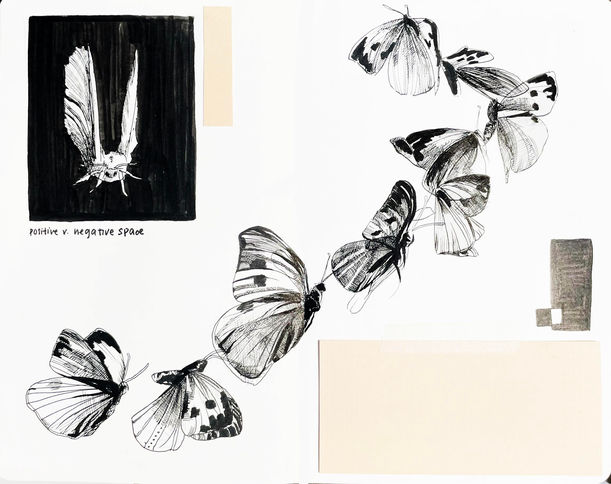
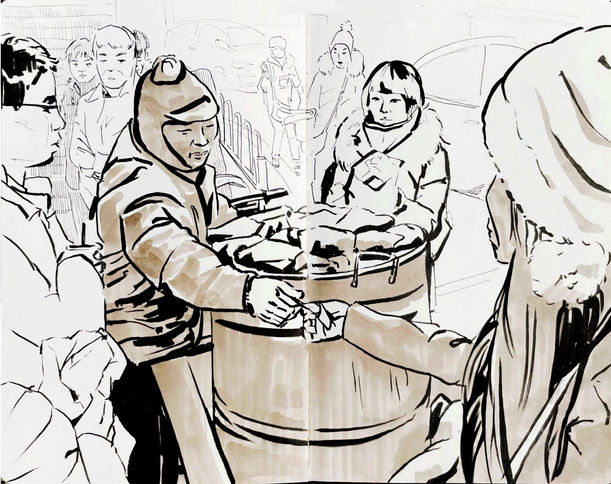
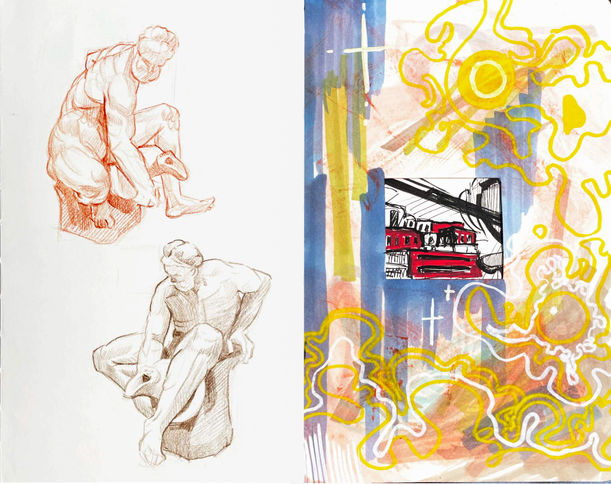
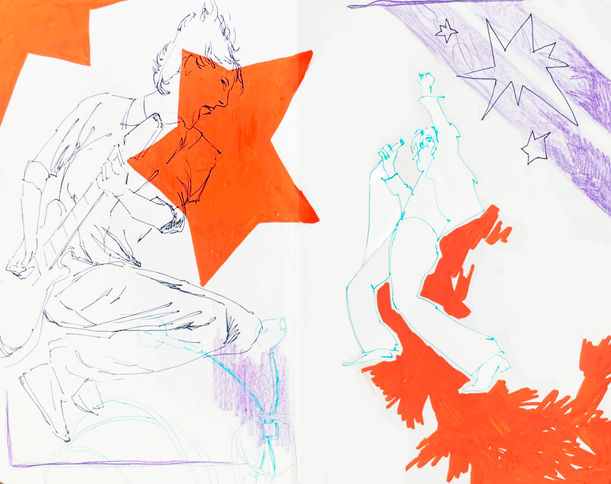
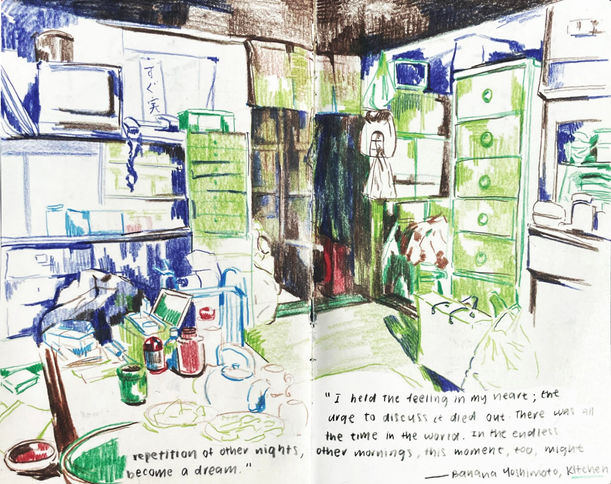
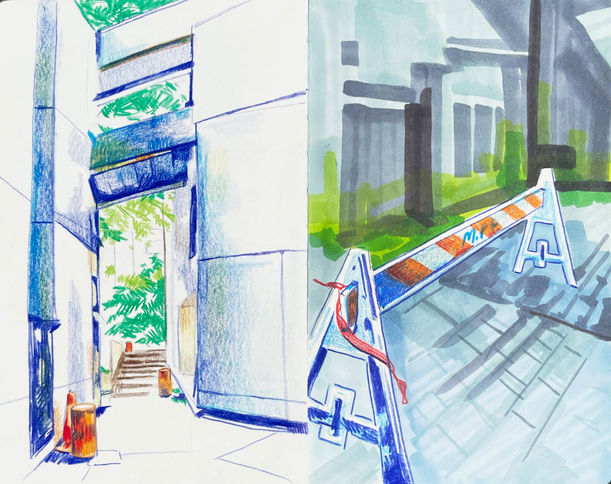
A glimpse of my sketchbook, featuring a collection of thoughts, people, places, and scribbles.
bottom of page